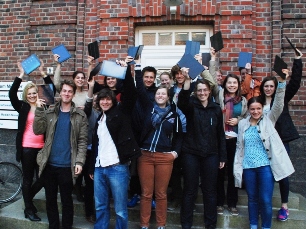
Returning home from a road trip through several US american medical libraries, I am even more convinced that just now, just today, we have the unique opportunity (or nightmare, depending on your point of view) to participate in the transition from the printed to the digital age. Brown University / Alpert Medical School’s Library consist of working places and computers only – no textbooks, and (almost) no librarian – it is well managed by a single person, halftime. The pride of Harvard’s Countway Library of Medicine is the „Center for Biomedical Informatics„, where the associate director of the library, Dr. Alexa T. McCray resides. And Yale’s Cushing Whitney Medical Library is very much into the iPad, both as a learning tool for freshmen and (with the iPad mini) as a patient tool for residents. Yale wants to create “Leaders of Medicine” and they imagine the iPad may well be a means for that purpose.
Transitioning from printed to digital age, the transition from printed to digital libraries is just a little facet for a society, that is shaken up by computer glasses, driverless cars, wearable technologies, and quantified selves. As part of this little facet, the transition from printed to the textbooks seems to be just a tiny yigsaw piece. But nevertheless, textbooks do represent a highly successful business model for both libraries and publishers, and therefore it is literally vital to know, when and how the transition process is starting if at all.
As a successor of the iPad lending project [1], since this year the Medical Library of the University of Münster is providing students with an iPad toolbox, serving as a modern, mobile and sustainable learning infrastructure. The toolbox is a pre-configured tablet computer with all the learning materials needed to pass the preclinical exams: electronic textbooks, anatomy apps, tools for exam preparations, and of course PDF annotating and note taking programs.
The project is a partnership between library, faculty, and major scientific publishers. Our goal is to gain a better understanding, how tablets and mobile learning applications affect the education of present and future students. After evaluating the study results, the logical next step would be to provide all freshmen students with such a device, giving them a tool as one single point of access to learning resources, study organization, e-learning, learning simulations as well as patient care.
There were two claims associated with the project called „easyphysikum„:
- The exam should be passed more easily
- No student has to come to the library anymore
At the moment 130 students are enrolled into the project, 70 having their own tablet computer and 60 loaning an iPad Air from the library for 5 months. Including the content provided by the publisher and staff resources, the project budget amounts to a quarter of a million Euro.
For such transition projects, investment and risk-taking are necessary. But this is quite worthwhile. As the example of the Brown’s Medical Library demonstrates, medical schools may well do without a pivotal medical library as we know it. To experiment with future-oriented learning environments may open up new ways to fulfill our very mission: providing (information) services to our users supporting them achieving their goals. Therefore we quite enthusiastic about the strong interest of universities, faculties, and libraries in this project even at this early stage.
(1) iPad lending project: First Results
This article was published in the June issue 2014, page 18.
Foto: (c) ZB Medizin